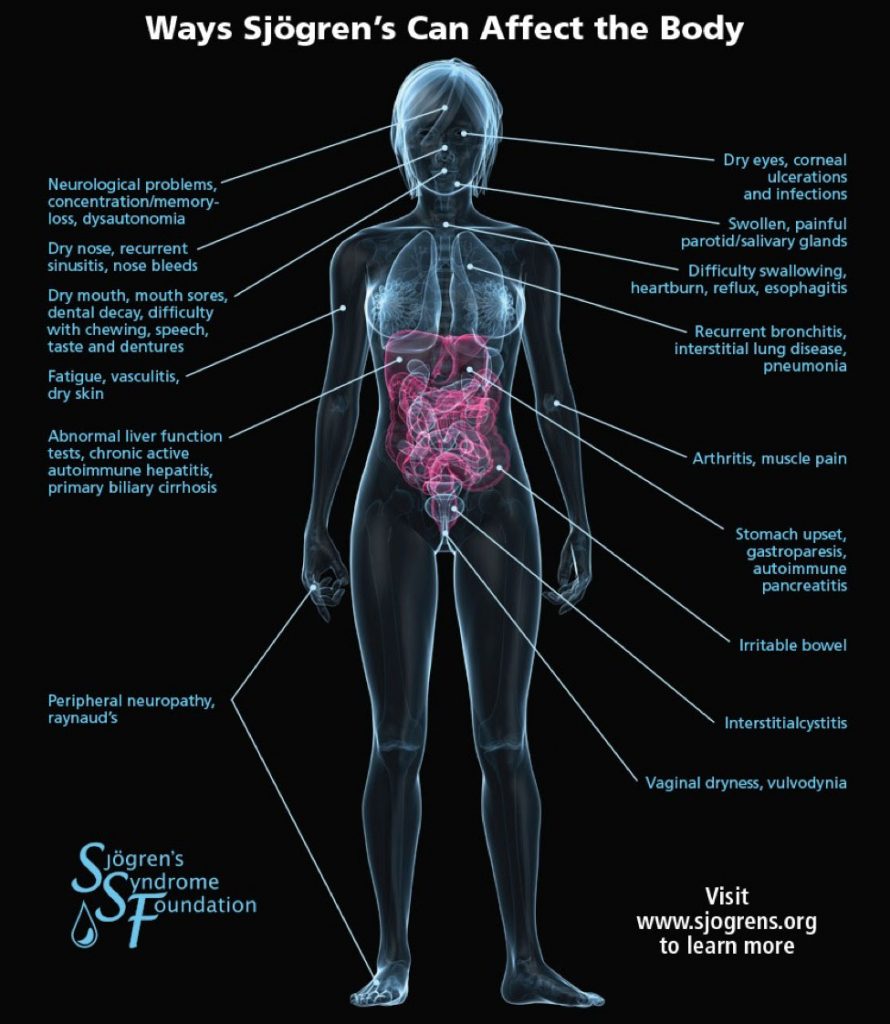Sjögren’s (“SHOW-grins”) Syndrome is a systemic autoimmune disease involving gland dysfunction that can affect the entire body.
Because Sjögren’s Syndrome is an autoimmune syndrome, it is found more commonly in families that have members with other autoimmune illnesses. In autoimmune disorders, the immune system, which normally protects the body from infection and cancers, may cause injury to the body’s own tissues.
The most common symptoms of Sjögren’s include excessive dryness of the eyes, mouth, and other mucous membranes; extreme fatigue, and chronic musculoskeletal pain. But Sjögren’s can also affect your organs and cause neuropathies and lymphomas.
See the Sjögren’s Syndrome Foundation’s website for a full list of Sjögren’s symptoms
https://www.sjogrens.org/home/about-sjogrens/symptoms
Primary Or Secondary Sjögren’s
Sjögren’s is usually classified as either primary or secondary. Primary Sjögren’s occurs by itself, and secondary Sjögren’s occurs when another connective tissue disease is present.
But neither classification is necessarily more severe than the other. Both Primary Sjögren’s and Secondary Sjögren’s patients can all experience the same level of discomfort, complications and seriousness of their disease.
Click here to learn more about Primary Sjögren’s vs. Secondary Sjögren’s
Glandular Effects:
Sjögren’s syndrome can dry out the mucous membranes lining the nose, throat, digestive tract, voice box (larynx), windpipe (trachea), airways of the lungs, and the vagina.
In some people, only the mouth or eyes are dry (a condition called sicca complex or sicca syndrome). But Dry eyes can lead to infections, inflammation of the eyelids, and abrasion of the cornea. And inflammation of the salivary glands can lead to mouth dryness, trouble swallowing, dental decay, cavities, gum disease, mouth sores and swelling/or infection of the parotid gland inside of the cheeks. And dryness of the respiratory tract may cause a persistent cough.
Possible Extraglandular Effects:
Aside from glandular issues, some diagnosed with Sjögren’s syndrome experience fatigue, joint pain or joint inflammation (arthritis), Raynaud’s phenomenon, lung inflammation, lymph node enlargement, and kidney, nerve, and muscle disease. A rare serious complication of Sjögren’s syndrome is inflammation of the blood vessels (vasculitis), which can damage organs and tissues that are supplied by these vessels.
Possible Central Nervous System (CNS) Complications
The most common CNS complications of Sjögren’s syndrome include “myelitis,” which is inflammation of the spinal cord. Myelitis can cause weakness, numbness, and other symptoms that can occur in MS. Because of this overlap in symptoms, patients with Sjögren’s syndrome may erroneously receive a diagnosis of MS.
https://www.hopkinssjogrens.org/disease-information/sjogrens-syndrome/neurologic-complications/
When we consider Sjögren’s on a disability level, we focus on the persistence of the symptoms. Imagine feeling like you have a terrible flu all day, every day. And the more you try to do, the harder it is to function and recover.
Recently we represented a Long-Term Disability Insurance client with Sjögren’s. We spoke to a Rheumatologist who had worked with many Sjögren’s patients. He noted that Sjorgren’s Syndrome is so disabling because the chronic dryness is such a threat to all the systems of the body.
Your body can’t function properly without hydration and lubrication. It’s like an engine that needs oil to keep running properly, but it keeps running out of oil.
If you have Sjögren’s Syndrome and have been denied LTD benefits, call toll-free (877)-428-9806 today for an evaluation of your claim. We’ll be happy to discuss your questions and concerns.

